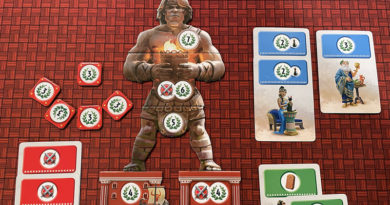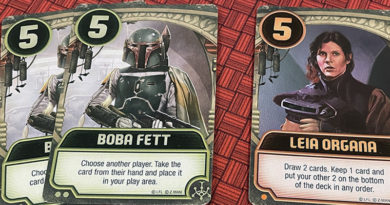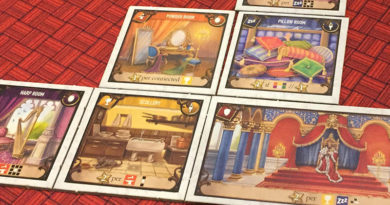Hues and Cues Board Game Review
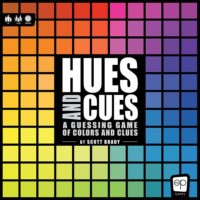
If I gave you the clue “Barney”, would you be able to pick it out of a grid of 480 colors?
What about “Mustard”, “Ocean Spray”, or “Slime”?
That’s the premise in a new game by The Op called Hues and Cues. And it’s much tougher than we first imagined.
But that doesn’t mean it’s not a fun game to play. The real question is will your family and friends enjoy playing it?
After all, that’s why we do these reviews — to give you a feel for a game and help you decide if it’s right for your group.
So let’s see where Hues and Cues may fall for you.
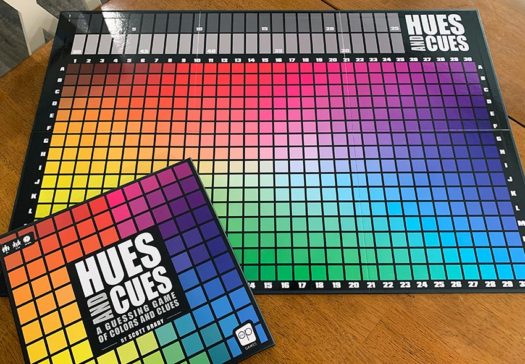
How to play Hues and Cues
Hues and Cues is a simple game to learn and play.
To begin, each player gets a set of color cones of their choice and places one on the score track. The color cards are shuffled and placed in a face-down draw stack and you’re ready to go.
On a player’s turn, they draw a color card and choose 1 of the 4 colors to be their target color. The location/coordinates of the color on the board is also listed below it on the card.
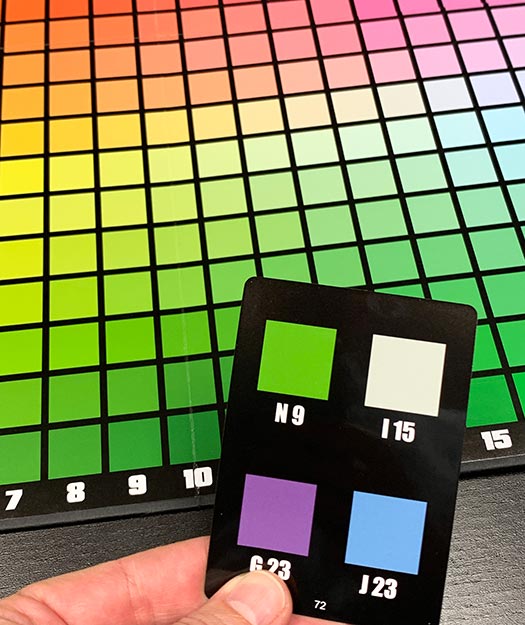
The player then gives a 1-word cue to describe their chosen color. And in clockwise order, each other player places one of their color cones on an empty square on the board they think the person is describing.
After each other player has placed their first cone, the cue-giver gives another cue. This time they may use 2 words to describe their chosen color. After this second cue, the other players go in reverse order (counter-clockwise) and place their last color cone on an empty square of their guess.
After this second pass, the cue-giver places the scoring frame on the board so that the target color is in the center of the scoring frame and players score points.
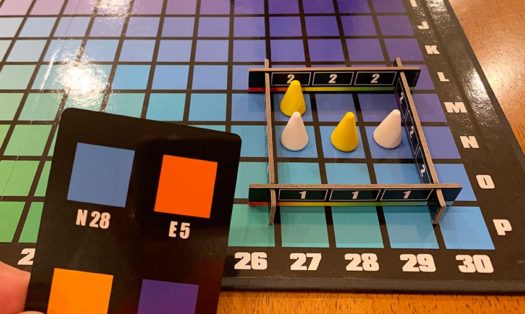
The cue-giver scores 1 point for every cone within the borders of the scoring frame.
The other players score points depending on where their cones are in relation to the scoring frame. Guessing the exact square is worth 3 points. Each cone within the frame but not in the exact center scores 2 points. And each cone adjacent to the frame on the outside scores 1 point.
After moving accordingly on the score track, players take back their cones, the scoring frame is removed from the board and the next player in turn order becomes the next cue-giver.
If playing with 4-6 players, each player gets to be the cue-giver twice. If playing with 7 or more, each player will be the cue-giver once. After all players have had their turns as cue-giver (once or twice), the game ends and the player with the most points wins!
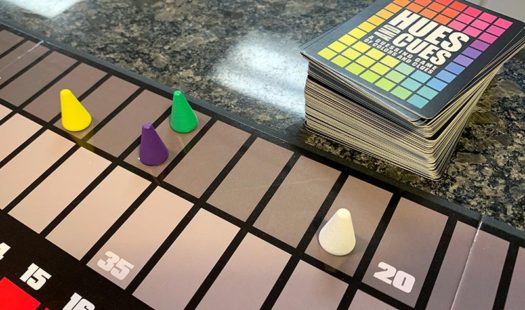
Can the whole family enjoy Hues and Cues?
When set out on a table, it’s hard not to stare at the Hues and Cues game board. The array of colors can be mesmerizing. And chances are, anyone who sees it out will be drawn to play.
And we’d say, “let them give it a shot!”
Sure the recommended age on the box say 8+, but we know younger kids will want to play too.
The big challenge though is coming up with those darn cues!
But at the same time, that’s what make the game so unique and fun…at least for some people.
Unfortunately, others may get too frustrated and not want to play again.
And we’ve encountered both.
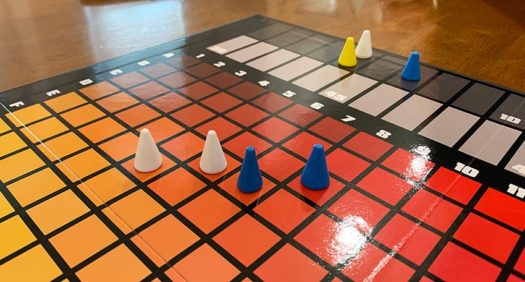
When we first opened the game, read the rules, and sat down to play, we thought it sounded super simple.
But then I drew my first card, chose a color I thought would work well, and then looked at the board and my mind went haywire.
I thought I had a great word cue to give for the green color I chose. But when I found it on the board and saw the huge variety of hues around it, my mind started scrambling for how my cue would be interpreted. Would it be descriptive enough?
How can I convey that hue of green in 1-stinking-word?
I’d go ahead with my first thought anyway — “Avocado”.
That’s when you realize how others see the world differently than you.
They started placing their first cones and the questions immediately arose — the green of an avocado on the outside or on the inside once you cut it open?
Yet, that’s also the beauty of the game!
Because then I had a chance to give another cue — up to two words to help zero them in on the right space. It could be as simple as saying “cut open”, “pre-cut”, “guacamole”, or changing it up and going a different route like “Douglas fir”.
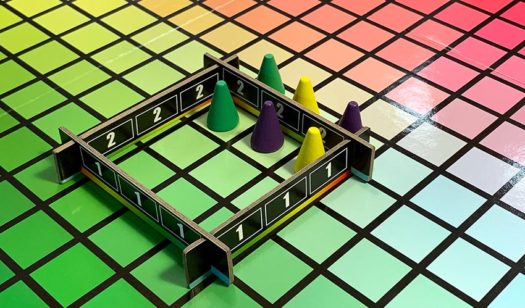
The biggest hit I’ve had with Hues and Cues is playing it with the design team at work.
This team of creatives live in color.
And they want to play over and over.
In fact, when playing with that group we don’t stop with just being the cue-giver twice. We just keep going until our lunch break is over.
Some rounds we’ve all hit really close to the chosen color and other times we’ve been super spread out all over the board. Those rounds usually bring a lot of laughs.
Most of our game plays have been with 4 or 5 players. But the game has enough color cones for 10 players to join in. And once we get past this COVID era, we’ll give it a shot with 10.
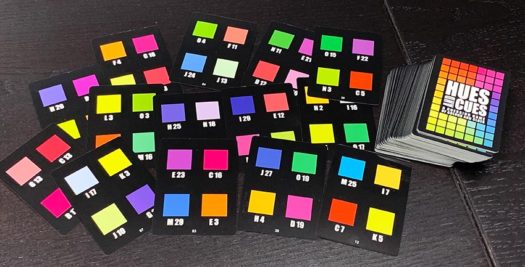
We really like that the scoring frame has numbers printed on the edges so you can easily remember how many points you get for being inside vs adjacent outside the walls.
We also like that the hue of grey are relegated to the scoring track. That keeps the colorful array of the game board bright.
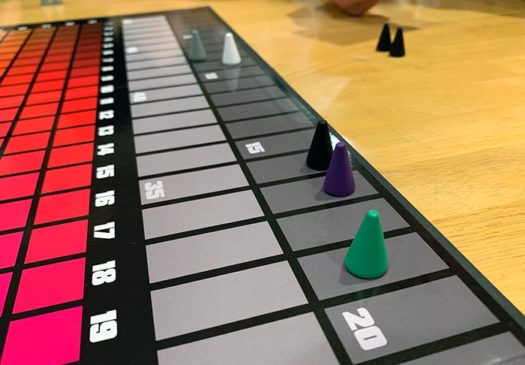
The one area where we’ve deviated from the game rules is having all players draw cards at the outset. Since the tough part (and most time-consuming part) of the game is coming up with the cues. By letting players have a card in hand long before their turns, they can be thinking of their potential cues before their turn comes. And that’s helped the games flow more smoothly.
We have yet to play with players who are colorblind, so we don’t know what they’ll think of the game. But we could only imagine it would be tough.
Hopefully our experience with the game, and this review, will help you judge if Hues and Cues might be a game your family and friends would enjoy playing.
How does Hues and Cues score on our “Let’s Play Again” game meter?
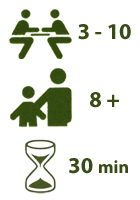 Our “let’s play again” game meter gets mixed results with Hues and Cues. Mom has been more on the side of “this is way to hard to come up with cues” whereas those at work are in the camp of “wish we could play it every day”.
Our “let’s play again” game meter gets mixed results with Hues and Cues. Mom has been more on the side of “this is way to hard to come up with cues” whereas those at work are in the camp of “wish we could play it every day”.
And I jump back and forth between the two.
Yes, it can be tricky to think of unique cues to narrow people toward a certain color space, but I like challenges. However, most of the games I’ve played I’ve been near the caboose on the score track. Yet every once in a while I get lucky and place some good guesses.
So yes it’s a keeper. It’s just going to be a game that I keep on the game shelves at my office rather than at home. (Yes, I have game shelves at the office…)
For those who think it will be a great fit for your crew, grab a copy of Hues and Cues.
We’d like to thank The Op for a review copy of Hues and Cues.



